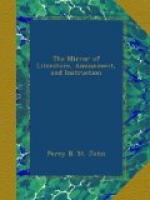“The Duke of Marlborough left behind him three daughters, all of them married into the best families of the kingdom. Henrietta, the eldest, the wife of Francis Earl of Godolphin, became on her father’s decease Duchess of Marlborough; but died in 1733, without male issue. Anne married Charles, Earl of Sunderland, from whom are descended the present Duke of Marlborough and the Earl of Spencer; and Mary gave her hand to the Duke of Montagu. The property which he had accumulated in the course of his long and busy life proved to be very great. In addition to the estates purchased for him by the country, he disposed by will of lands and money, of which the interest fell not short of 100,000L a year; indeed, the annual revenue bequeathed to his successors in Woodstock alone is given on the best authority at 70,000L. The mansion house at Blenheim was at the period of his death still in progress of erection, and he set apart a sum of money for the purpose of completing it, of which he committed the management exclusively to the duchess, who survived her husband many years. It seems alone necessary to add to this, that the estates of Woodstock are held on feudal tenure, the occupant presenting to the king once a year a standard similar to those which the founder of his house captured; and that these are regularly deposited in a private chapel at Windsor, where they may still be seen by the curious.
“The funeral of this illustrious warrior and statesman was of course as magnificent as his reputation and the honour of the country seemed to require. His body, after undergoing the process of embalming, and lying in state at Marlborough House, was conveyed in a sort of triumphal car to Westminster Abbey, long lines of carriages following, and all the parade of troops, heralds, and mourners preceding and surrounding the senseless clay. A gorgeous canopy overshadowed it, adorned with plumes, military trophies, and heraldic achievements. Dukes and earls were the chief mourners; the pall being borne by persons of not less eminent rank; and the cavalcade was received by the light of blazing torches at the door of the abbey by all the dignitaries and ministers of the church in full canonicals. Yet was the solemn ceremony performed for no other purpose than to render due honours to the remains of England’s most illustrious commander. The body was not permitted for any length of time to rest where, amid such splendous, it had been entombed; but, being removed to the chapel at Blenheim, it was finally deposited in a mausoleum, erected by Rysbrack, under the superintendence of the duchess.”
Altogether this volume maintains the creditable character of the series to which it belongs.
* * * * *
SPANISH CHARACTERISTICS—BY WASHINGTON IRVING.[6]
[6] From the Alhambra.—See
also, Supplement published with
the present Number.




